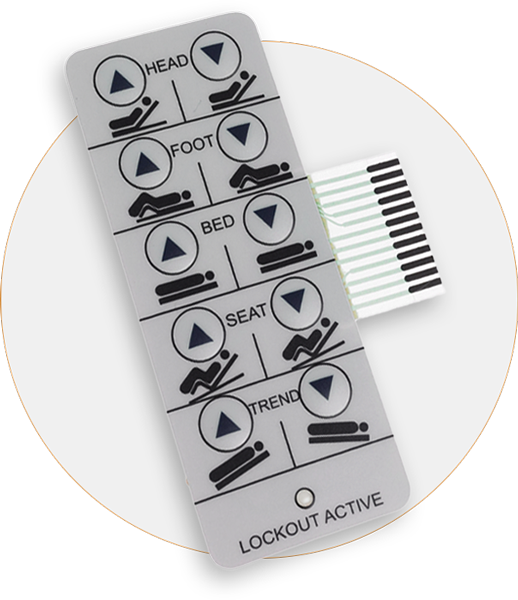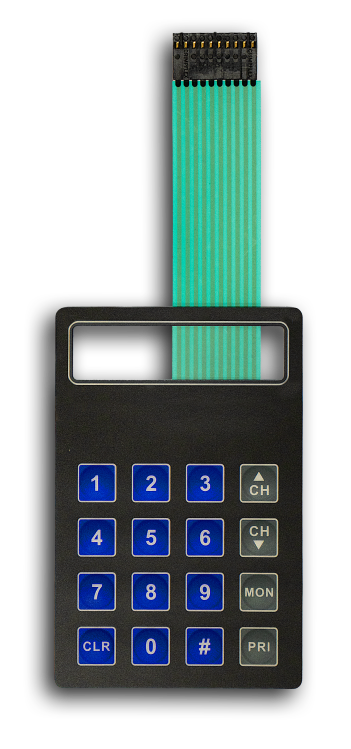How Membrane Switches Are Used in Medical Devices and Equipment
How Membrane Switches Are Used in Medical Devices and Equipment
Blog Article
Comprehending the Importance of Membrane Switches in Customer User Interfaces
Membrane buttons are important components in the style of effective individual interfaces, helping with not only performance yet also improving aesthetic appeal and user communication. As we check out the numerous benefits and future fads associated with Membrane modern technology, it comes to be clear that these switches are a lot more than simply components; they represent a merging of advancement and practicality.
What Are Membrane Buttons?

The spacer layer, which consists of adhesive homes, enables for the separation of the circuit layer from the overlay, making sure that the button remains in a non-activated state until pushed. When stress is used to the overlay, it presses the spacer layer, linking the gap and completing the circuit in the underlying layer. This layout not only lowers the physical room required for conventional mechanical switches however likewise improves the durability of the gadget, as Membrane buttons are generally resistant to dirt, wetness, and various other ecological variables.
Commonly discovered in applications varying from customer electronic devices to medical tools, Membrane buttons are indispensable to contemporary innovation, giving a effective and user-friendly user interface that aligns with modern style requirements.
Advantages of Membrane Buttons
While many switch technologies exist, Membrane Switches offer distinctive advantages that make them particularly desirable in numerous applications. Among the key benefits of Membrane buttons is their portable design, which enables space-saving applications in gadgets where property is limited. Their thin profile not just enhances aesthetic appeal but additionally facilitates light-weight building and construction.
One more significant advantage is their resistance to environmental factors. Membrane buttons are generally secured against wetness, dirt, and impurities, making them perfect for use sought after environments, such as clinical devices and commercial tools. This resilience extends the life expectancy of the button, minimizing upkeep expenses and enhancing dependability.
In addition, Membrane buttons can be customized to meet specific layout requirements, incorporating unique graphics and colors that boost user interaction. Their responsive feedback alternatives can likewise be customized to supply a satisfying individual experience. In addition, Membrane switches are affordable, particularly in high-volume applications, as they can be created efficiently.
Applications in Various Industries

In the consumer electronic devices field, Membrane buttons are common in tools such as microwaves, cleaning devices, and remote controls. Their responsive responses and aesthetic options enhance customer experience while providing a smooth, modern appearance. In addition, automotive manufacturers use Membrane buttons in dashboard controls and infomercial systems, where space is limited, and individual involvement is important.
In addition, the commercial field leverages Membrane buttons in control panels for machinery and devices, permitting user-friendly procedure in commonly rough atmospheres. Their resistance to chemicals and dampness ensures long life and integrity in these applications. Generally, the adaptability of Membrane Switches contributes considerably to their prevalent use, making them important in numerous technical domains.
Layout Considerations for Membrane Switches

When developing Membrane switches, several key considerations need to be taken right into account to ensure ideal functionality and user experience. To start with, the choice of products is essential; selecting resilient, premium substratums can enhance the button's longevity and resistance to environmental aspects such as dampness and temperature level variations.
Second of all, the layout of the graphic overlay ought to prioritize clearness and convenience of use. Symbols and message have to be legible, and the design must facilitate instinctive communication (membrane switches). Additionally, tactile comments is important; integrating a responsive dome or other devices can enhance the user experience by giving physical confirmation of activation
An additional crucial variable is the button's electric efficiency. Designers have to make sure that the conductive traces are effectively created to lessen resistance and avoid signal interference. This involves examining the needed actuation pressure and making sure compatibility with the electronic components they will certainly user interface with.

Future Fads in Membrane Technology
As modern technology remains to development, Membrane switches are positioned to progress significantly, driven by advancements in materials and making methods. One emerging pattern is the unification of innovative materials, such as versatile substratums and conductive inks, which improve sturdiness and reduce the total weight of Membrane buttons. These materials not only enhance the responsive feedback but likewise permit the layout of switches that see post can hold up against harsher ecological conditions.
Furthermore, the assimilation of touch-sensitive modern technologies is changing typical Membrane Switches into more interactive customer interfaces. Capacitive touch sensors installed within Membrane button panels can offer a more receptive and user-friendly individual experience, lining up with the expanding demand for streamlined, modern styles in customer electronics.
Furthermore, advancements in printing strategies, such as electronic and 3D printing, enable find fast prototyping and modification of Membrane switches. This adaptability allows manufacturers to respond quicker to market demands and consumer preferences.
Lastly, sustainability is becoming a substantial emphasis, with manufacturers checking out green products and processes. As these trends unravel, the future of Membrane modern technology guarantees boosted capability, visual allure, and environmental responsibility, strengthening their role in advanced interface across various markets.
Verdict
In verdict, Membrane Switches represent a crucial element in the style of user interfaces, combining performance with aesthetic versatility. As developments in innovation continue, the development of Membrane buttons is anticipated to more improve customer interfaces, driving technology and enhancing use in a progressively complicated technical landscape.
Membrane switches are essential parts in the style of reliable user interfaces, helping with not only performance but additionally improving visual appeal and customer communication.Membrane Switches offer as a vital component in various user interfaces, promoting a smooth communication in between users and electronic tools.While various switch modern technologies exist, Membrane Switches offer distinct benefits that make them especially preferable in various applications.Moreover, Membrane switches can be personalized to fulfill particular design demands, integrating unique graphics and shades that improve customer interaction.In final thought, Membrane Switches represent an essential element in the design of user interfaces, incorporating capability with visual flexibility.
Report this page